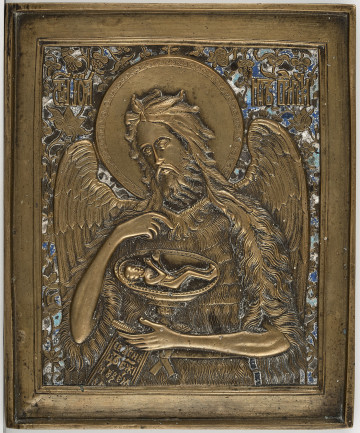
St. John the Baptist
20th century
Castle Museum in Łańcut
Part of the collection: Icons
In addition to the twelve most important feasts of the liturgical year, the feast of the Pocrov of the Most Holy Lady Theotokos is one of the most solemn. The feast is celebrated by most Eastern Christian churches on the 14th of October (1st of October in the Julian calendar). It is based on the vision seen by Andrei Yurodivy, a 'holy fool', in the Church of the Mother of God in Blachernae, Constantinople. It was one of the most important churches in the capital of the Empire, funded in the 5th c. by Empress Pulcheria. The temple was famous for the relics of the robes of the Mother of God, among which was the maphorion - a fold of cloth worn on the head and partially covering the figure of a married woman. During an all-night service, Andrew Yurodivy, staying in the Blachernae temple together with his disciple Epiphanius, had a miraculous vision. This event was cited by Christian writers in the life of St. Andrew the Fool without specifying either its date or day. Yurodivy saw the Mother of God hovering in the air, as she descended with her hands spread and raised in a gesture of prayer, supported on both sides by the saints John the Baptist and John the Evangelist. She was accompanied by a host of saints. The Mother of God, holding up her maphorion which shone with an unearthly brilliance, stopped in front of the sanctuary and immersed herself in prayer. Then, taking off her head covering, she unfolded it over those gathered in the temple as a sign of her care and moved away, becoming invisible. Later Christian writers dated the event to Sunday, the 1st of October 910, during the reign of Emperor Leo VI and Patriarch Macarius, when Constantinople was in danger during the war with Saracens. The miraculous event, depicted on the displayed icon, was the origin of the feast known as Pokrov of the Purest Lady Theotokos. Specific historical figures appear in the composition of the image; this is described under S.12822MŁ and S.12951MŁ. Teresa Bagińska-Żurawska https://orcid.org/0000-0002-9243-3967
Dimensions
height: 46 cm, width: 40 cm
Object type
Icons
Technique
gilding, tempera
Material
gold, tempera, wood
Origin / acquisition method
decyzja administracyjna
Creation time / dating
Creation / finding place
Owner
Castle Museum in Łańcut
Identification number
Location / status

20th century
Castle Museum in Łańcut

19th (?) century
Castle Museum in Łańcut

1800 — 1850
Castle Museum in Łańcut
DISCOVER this TOPIC
Museum of King Jan III's Palace at Wilanów
DISCOVER this PATH
Educational path